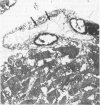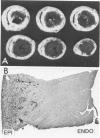Abstract
The purpose of this study was to compare the functional and morphologic changes that occur during ischemic contracture and reperfusion in the normal and hypertrophied heart. Hearts from Sprague-Dawley, spontaneously hypertensive (SHR), and normotensive Wistar-Kyoto rats were evaluated using a modified Langendorff perfusion apparatus. After obtaining control data, hearts were potassium-arrested, made ischemic, and studied at various time points. Regional coronary flow was assessed with the use of radiolabeled microspheres or Microfil dye infusion, and morphologic changes were evaluated by means of light and electron microscopy. Sarcomere length changes and qualitative morphologic changes during global ischemia demonstrate a transmural progression of ischemic damage starting at the endocardium and extending, with time, epicardially. The progression of ischemic changes in hypertrophied hearts of SHRs was similar to that of normal hearts; however, hypertrophied hearts developed ischemic contracture sooner than normal hearts. In addition, the development of contraction band change after ischemic contracture occurred only when hearts were reperfused and was related to the development of no-reflow.
Full text
PDF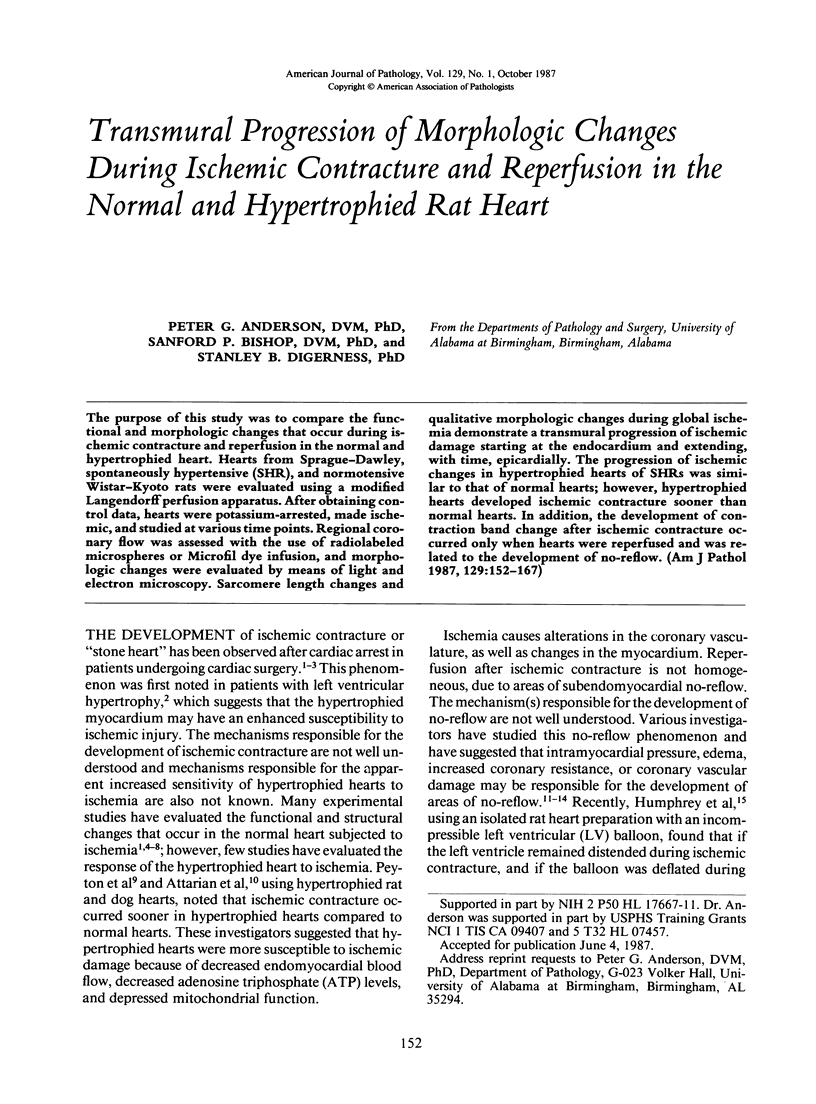
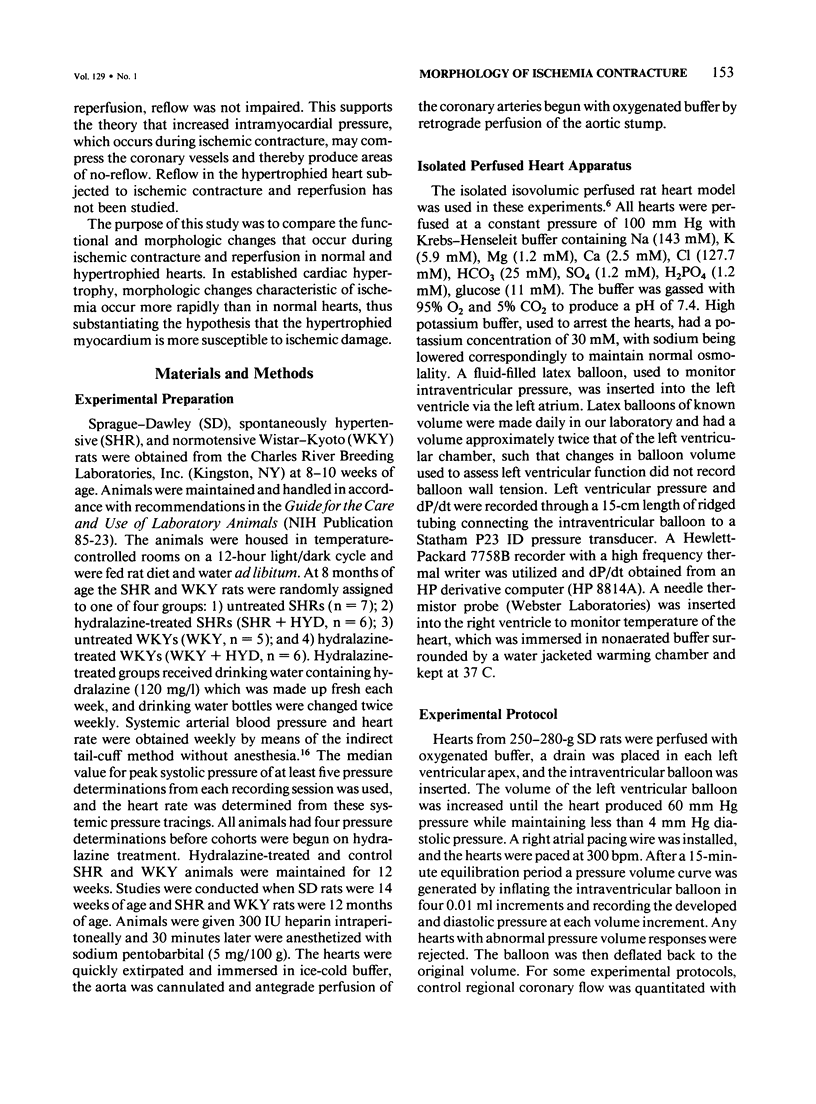
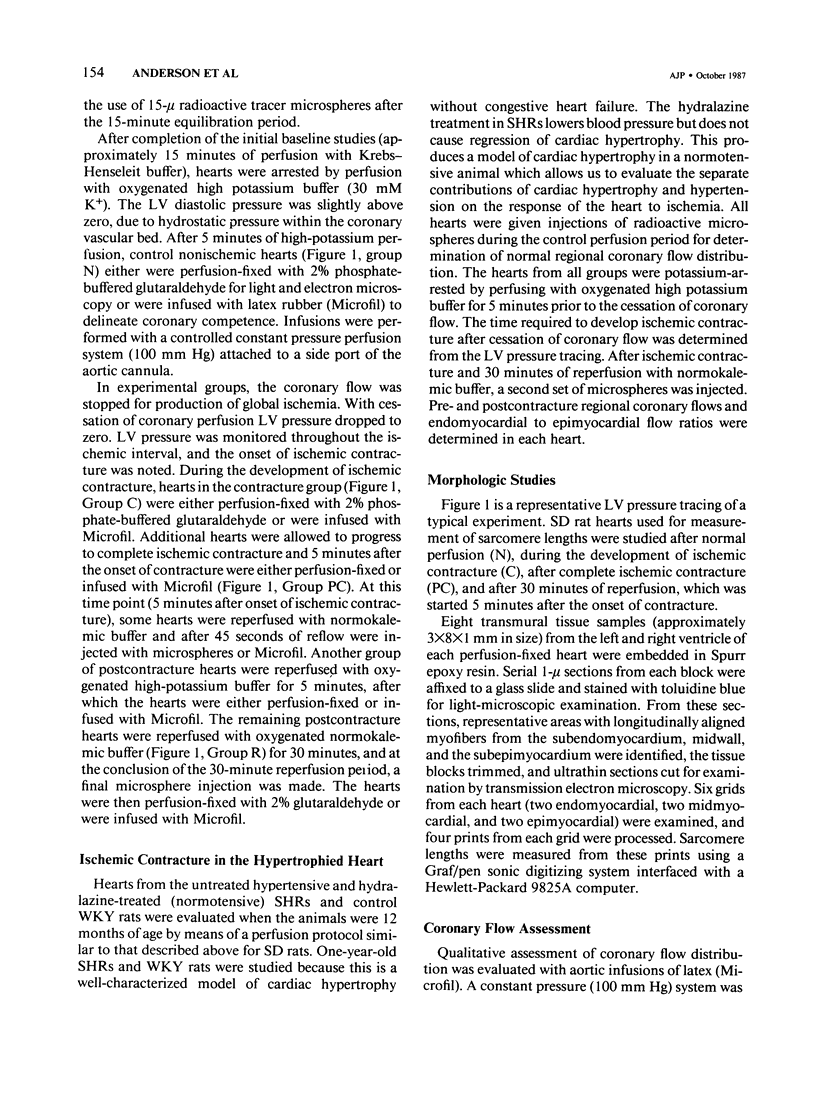
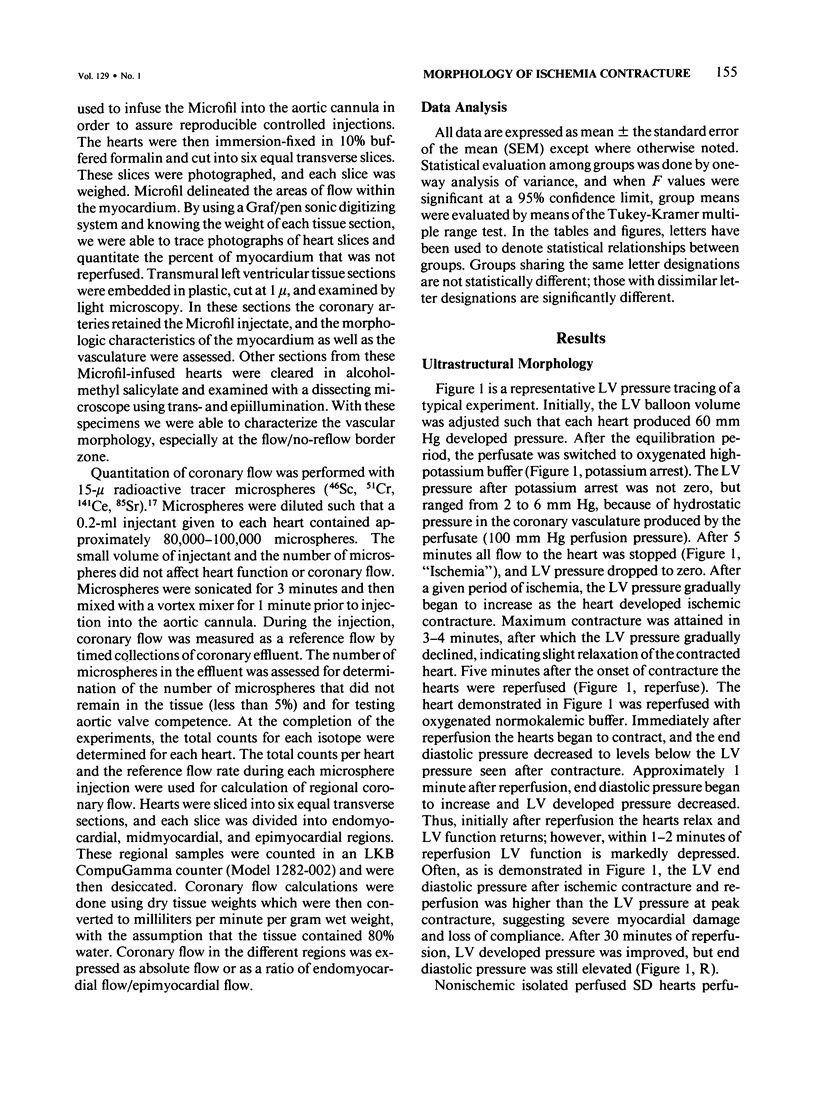
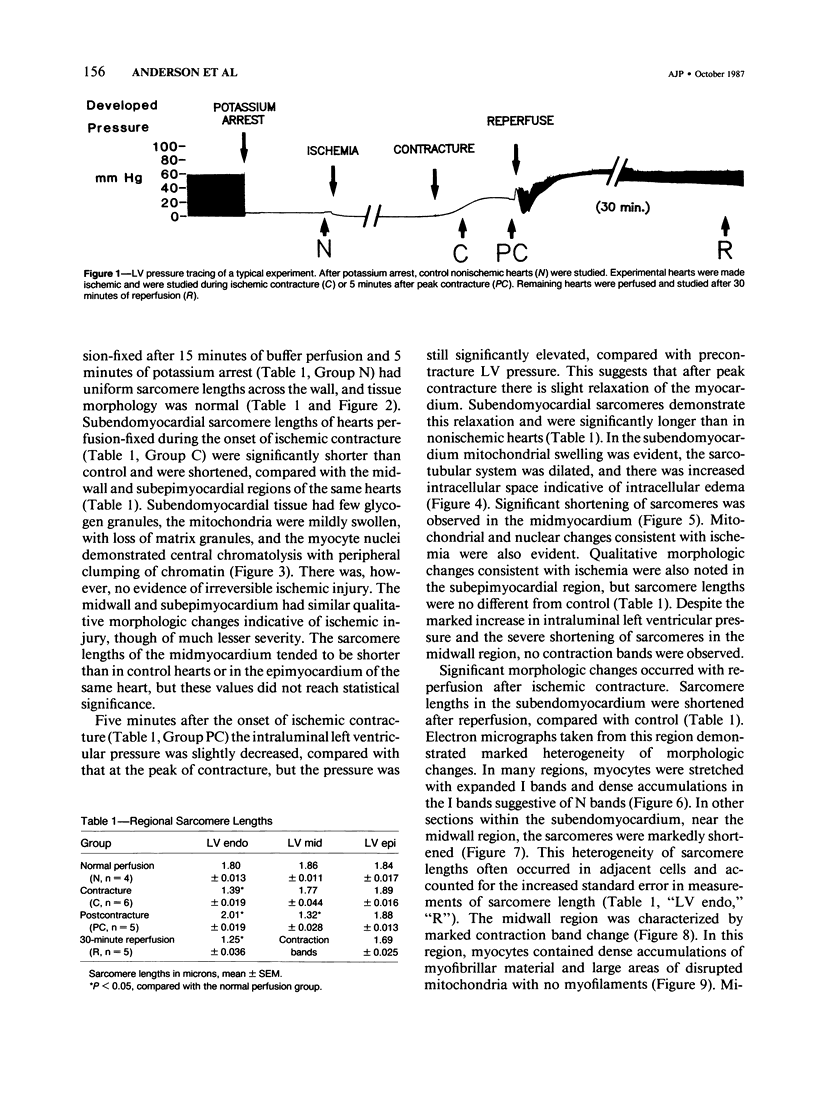
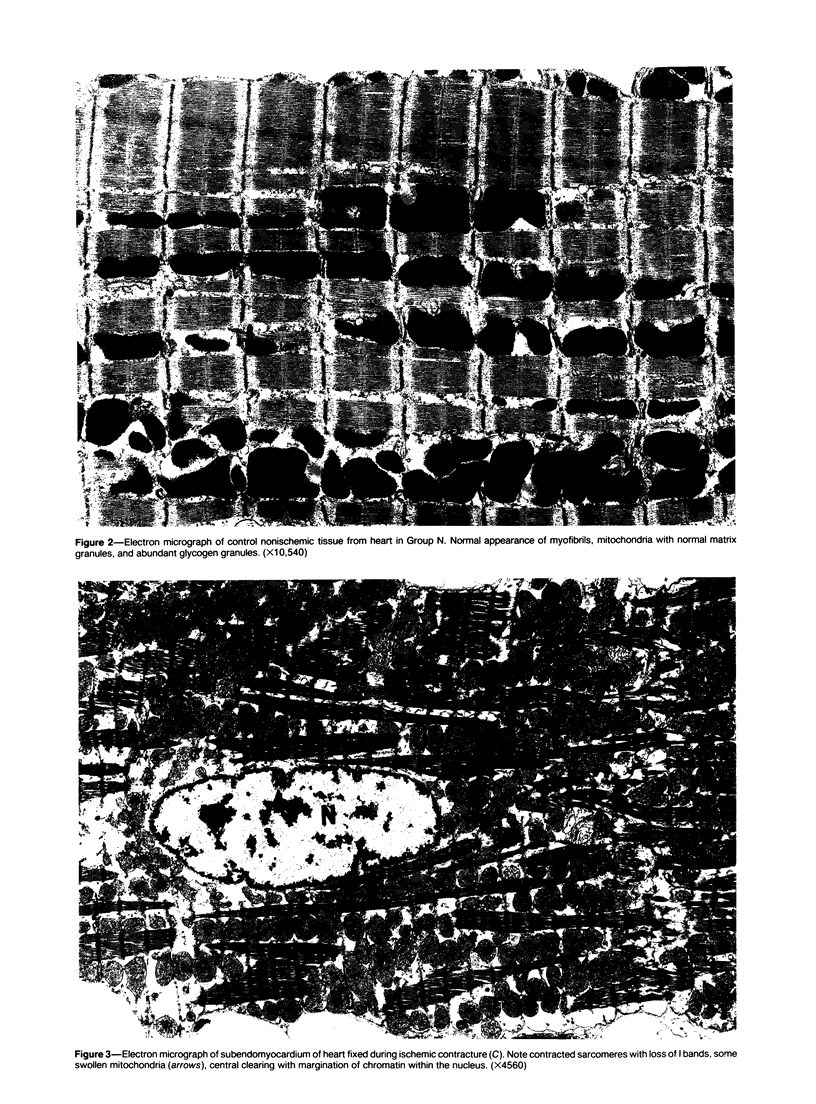
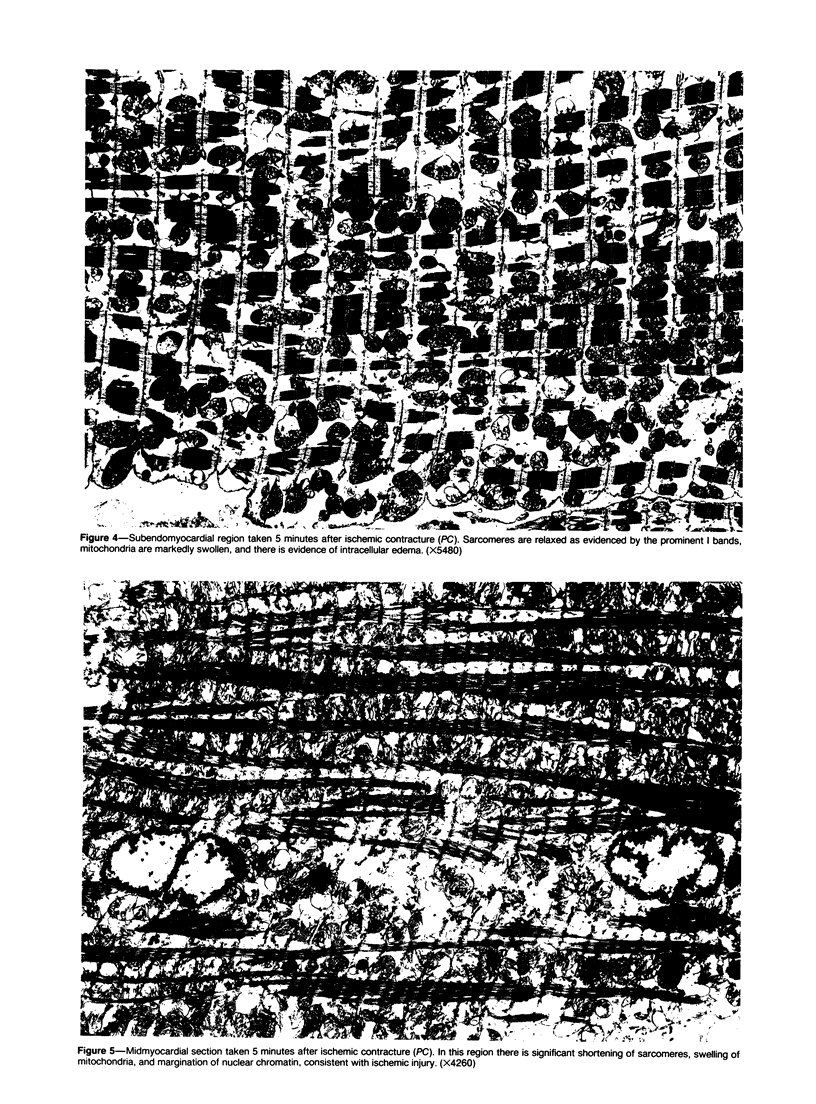
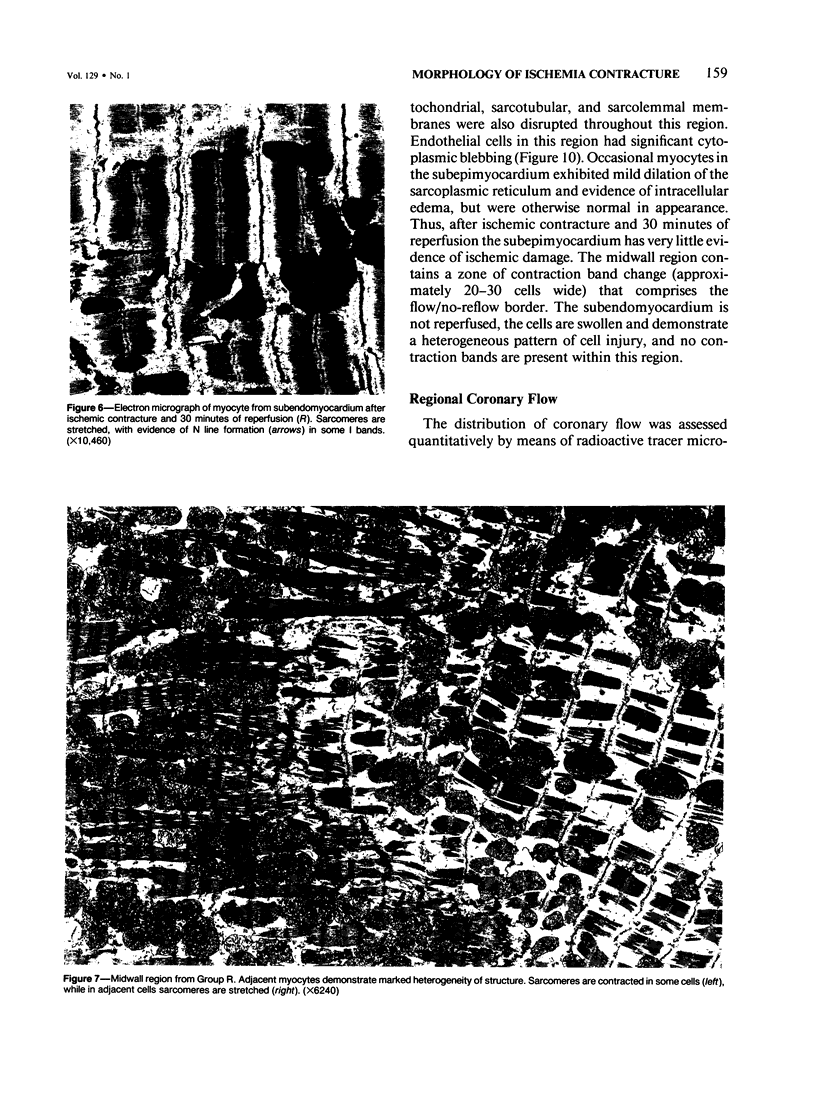

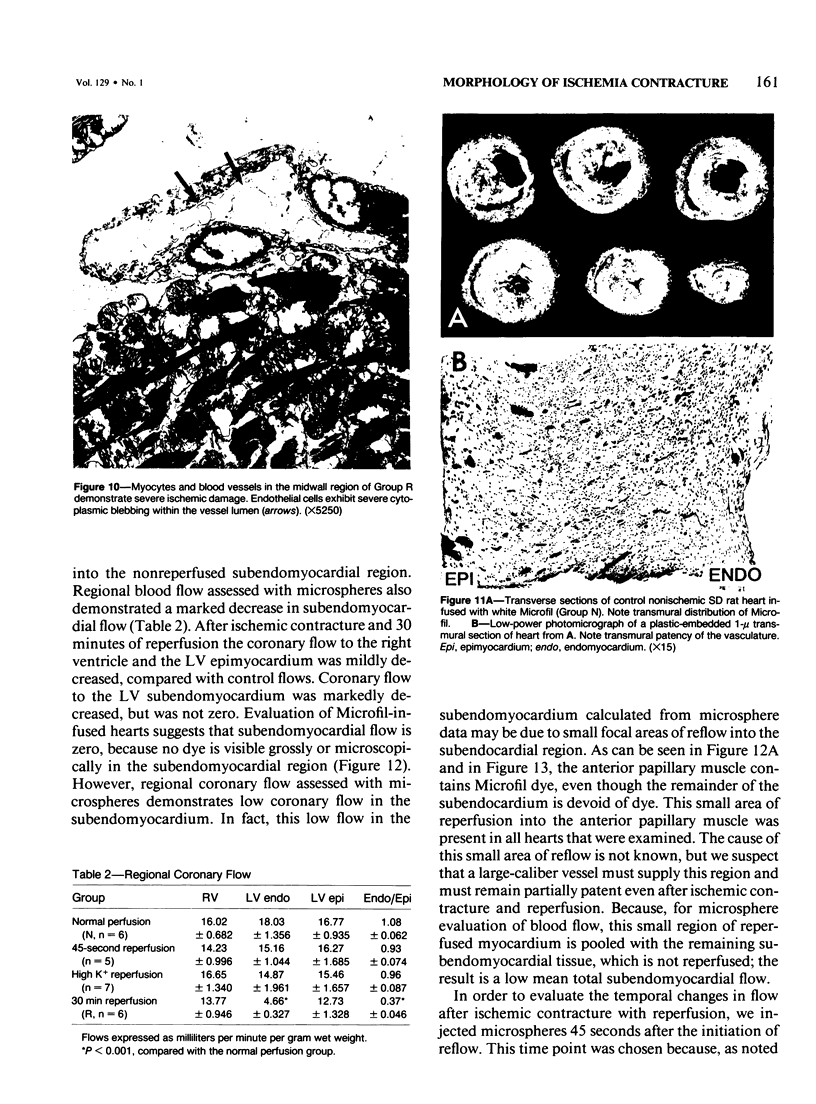
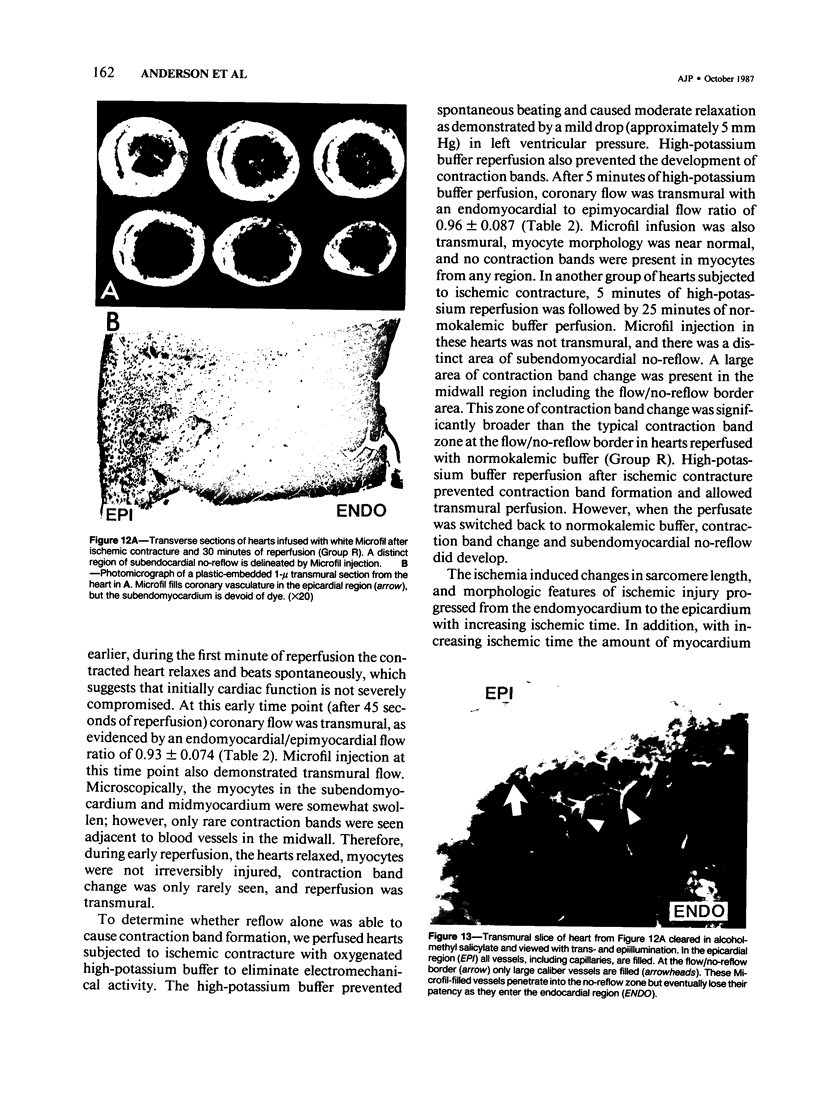
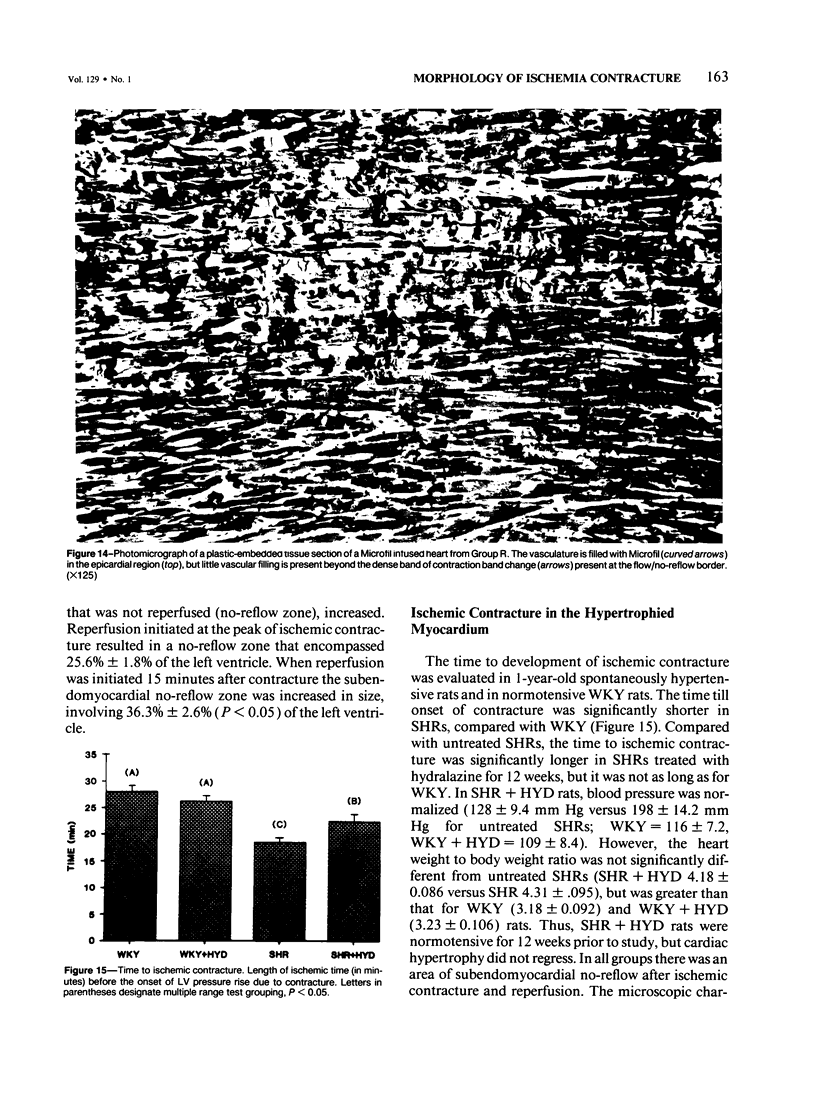
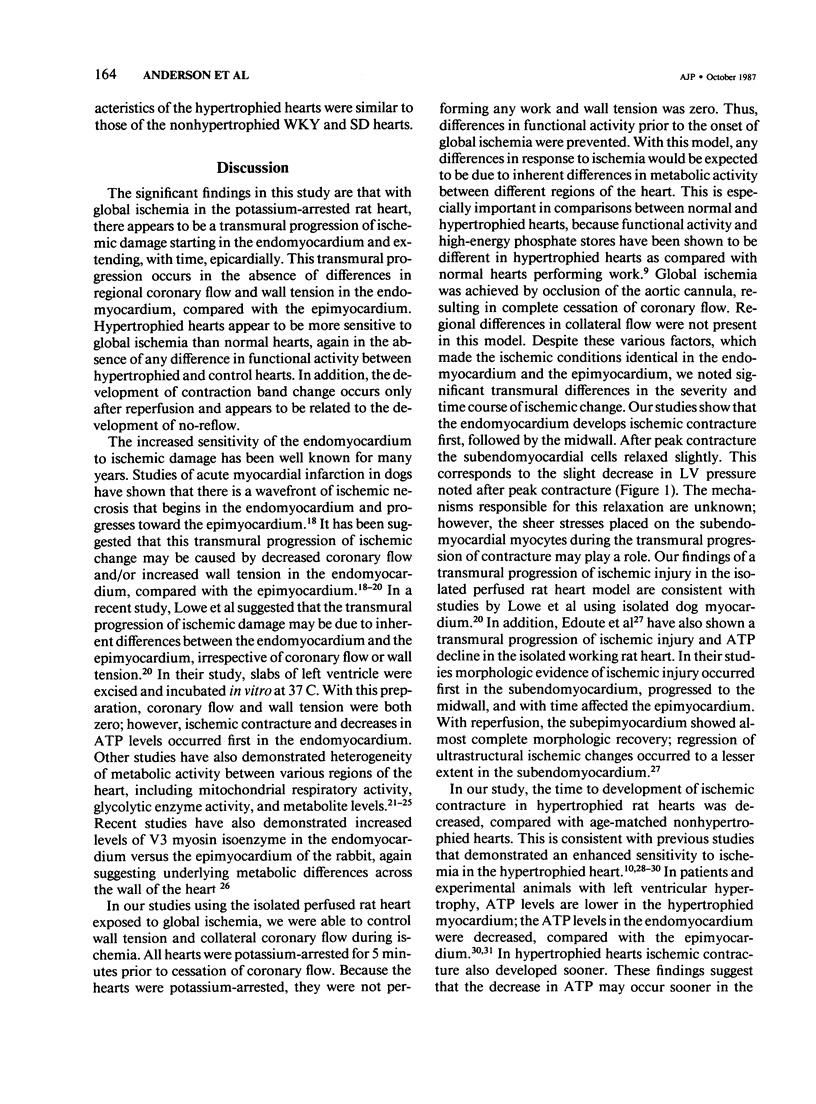
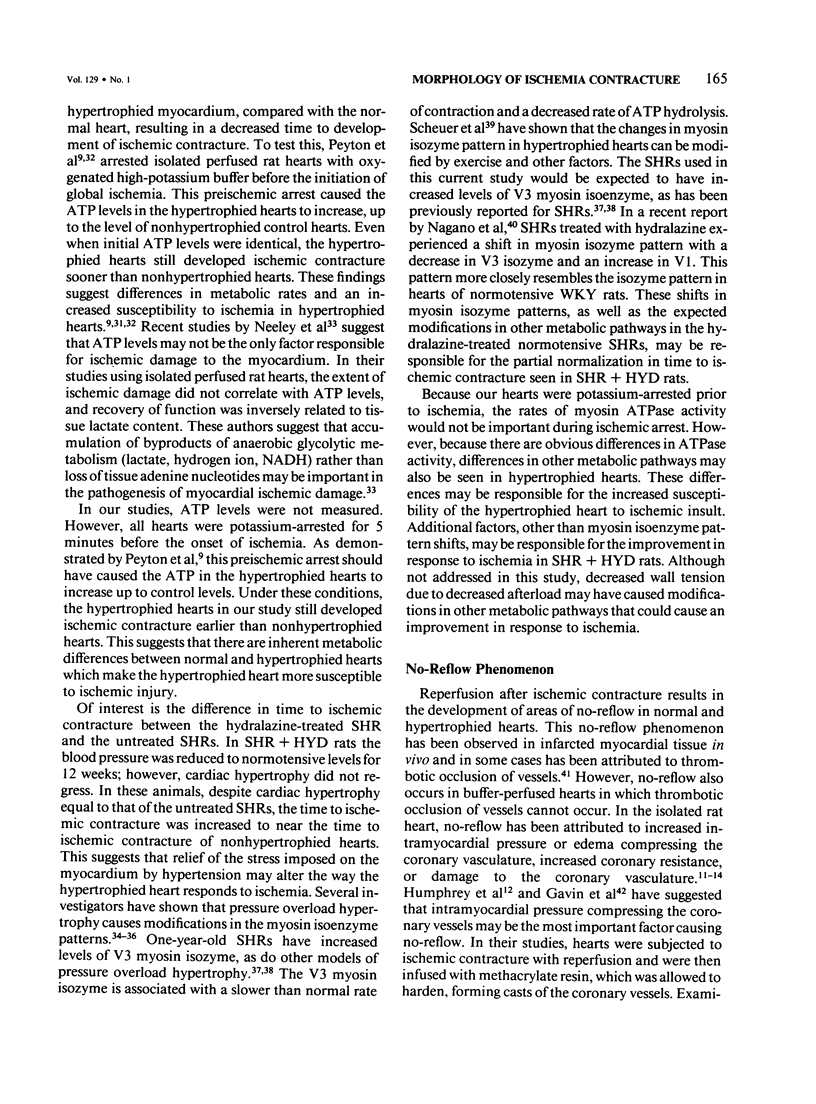
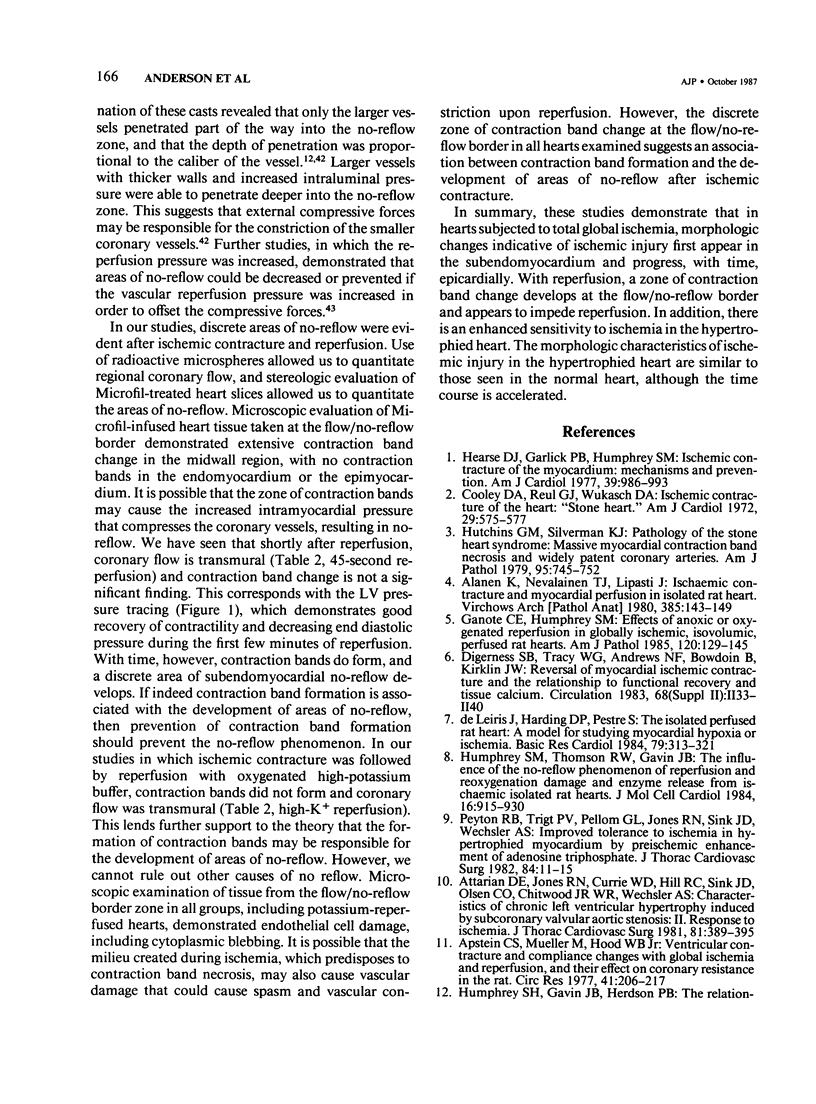
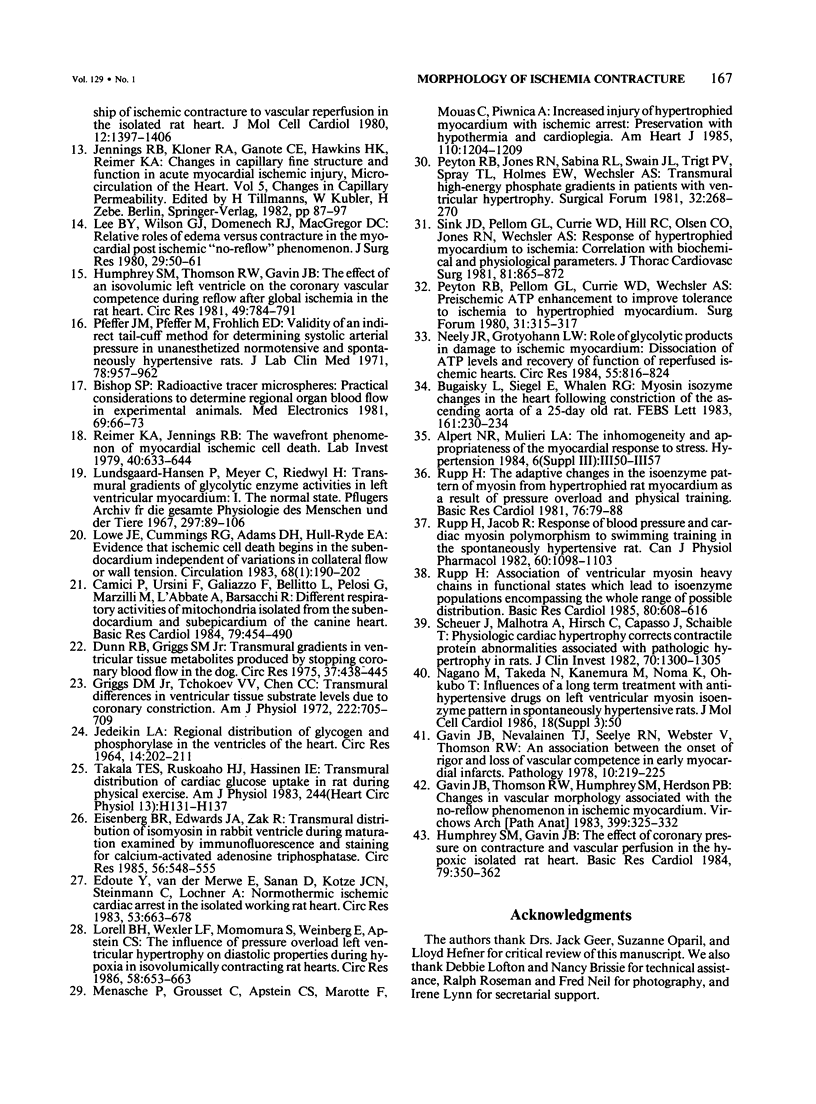
Images in this article
Selected References
These references are in PubMed. This may not be the complete list of references from this article.
- Alanen K., Nevalainen T. J., Lipasti J. Ischaemic contracture and myocardial perfusion in isolated rat heart. Virchows Arch A Pathol Anat Histol. 1980;385(2):143–149. doi: 10.1007/BF00427400. [DOI] [PubMed] [Google Scholar]
- Alpert N. R., Mulieri L. A. The inhomogeneity and appropriateness of the myocardial response to stress. Hypertension. 1984 Nov-Dec;6(6 Pt 2):III50–III57. doi: 10.1161/01.hyp.6.6_pt_2.iii50. [DOI] [PubMed] [Google Scholar]
- Apstein C. S., Mueller M., Hood W. B., Jr Ventricular contracture and compliance changes with global ischemia and reperfusion, and their effect on coronary resistance in the rat. Circ Res. 1977 Aug;41(2):206–217. doi: 10.1161/01.res.41.2.206. [DOI] [PubMed] [Google Scholar]
- Attarian D. E., Jones R. N., Currie W. D., Hill R. C., Sink J. D., Olsen C. O., Chitwood W. R., Jr, Wechsler A. S. Characteristics of chronic left ventricular hypertrophy induced by subcoronary valvular aortic stenosis. II. Response to ischemia. J Thorac Cardiovasc Surg. 1981 Mar;81(3):389–395. [PubMed] [Google Scholar]
- Bugaisky L. B., Siegel E., Whalen R. G. Myosin isozyme changes in the heart following constriction of the ascending aorta of a 25-day old rat. FEBS Lett. 1983 Sep 19;161(2):230–234. doi: 10.1016/0014-5793(83)81014-x. [DOI] [PubMed] [Google Scholar]
- Camici P., Ursini F., Galiazzo F., Bellitto L., Pelosi G., Marzilli M., L'Abbate A., Barsacchi R. Different respiratory activities of mitochondria isolated from the subendocardium and subepicardium of the canine heart. Basic Res Cardiol. 1984 Jul-Aug;79(4):454–460. doi: 10.1007/BF01908146. [DOI] [PubMed] [Google Scholar]
- Cooley D. A., Reul G. J., Wukasch D. C. Ischemic contracture of the heart: "stone heart". Am J Cardiol. 1972 Apr;29(4):575–577. doi: 10.1016/0002-9149(72)90454-7. [DOI] [PubMed] [Google Scholar]
- Dunn R. B., Griggs D. M., Jr Transmural gradients in ventricular tissue metabolites produced by stopping coronary blood flow in the dog. Circ Res. 1975 Oct;37(4):438–445. doi: 10.1161/01.res.37.4.438. [DOI] [PubMed] [Google Scholar]
- Edoute Y., van der Merwe E., Sanan D., Kotzé J. C., Steinmann C., Lochner A. Normothermic ischemic cardiac arrest of the isolated working rat heart. Effects of time and reperfusion on myocardial ultrastructure, mitochondrial oxidative function, and mechanical recovery. Circ Res. 1983 Nov;53(5):663–678. doi: 10.1161/01.res.53.5.663. [DOI] [PubMed] [Google Scholar]
- Eisenberg B. R., Edwards J. A., Zak R. Transmural distribution of isomyosin in rabbit ventricle during maturation examined by immunofluorescence and staining for calcium-activated adenosine triphosphatase. Circ Res. 1985 Apr;56(4):548–555. doi: 10.1161/01.res.56.4.548. [DOI] [PubMed] [Google Scholar]
- Ganote C. E., Humphrey S. M. Effects of anoxic or oxygenated reperfusion in globally ischemic, isovolumic, perfused rat hearts. Am J Pathol. 1985 Jul;120(1):129–145. [PMC free article] [PubMed] [Google Scholar]
- Gavin J. B., Nevalainen T. J., Seelye R. N., Webster V., Thomson R. W. An association between the onset of rigor and loss of vascular competence in early myocardial infarcts. Pathology. 1978 Jul;10(3):219–225. doi: 10.3109/00313027809063504. [DOI] [PubMed] [Google Scholar]
- Gavin J. B., Thomson R. W., Humphrey S. M., Herdson P. B. Changes in vascular morphology associated with the no-reflow phenomenon in ischaemic myocardium. Virchows Arch A Pathol Anat Histopathol. 1983;399(3):325–332. doi: 10.1007/BF00612950. [DOI] [PubMed] [Google Scholar]
- Griggs D. M., Jr, Tchokoev V. V., Chen C. C. Transmural differences in ventricular tissue substrate levels due to coronary constriction. Am J Physiol. 1972 Mar;222(3):705–709. doi: 10.1152/ajplegacy.1972.222.3.705. [DOI] [PubMed] [Google Scholar]
- Hearse D. J., Garlick P. B., Humphrey S. M. Ischemic contracture of the myocardium: mechanisms and prevention. Am J Cardiol. 1977 Jun;39(7):986–993. doi: 10.1016/s0002-9149(77)80212-9. [DOI] [PubMed] [Google Scholar]
- Humphrey S. M., Gavin J. B., Herdson P. B. The relationship of ischemic contracture of vascular reperfusion in the isolated rat heart. J Mol Cell Cardiol. 1980 Dec;12(12):1397–1406. doi: 10.1016/0022-2828(80)90124-8. [DOI] [PubMed] [Google Scholar]
- Humphrey S. M., Gavin J. B. The effect of coronary pressure on contracture and vascular perfusion in the hypoxic isolated rat heart. Basic Res Cardiol. 1984 May-Jun;79(3):350–362. doi: 10.1007/BF01908036. [DOI] [PubMed] [Google Scholar]
- Humphrey S. M., Thomson R. W., Gavin J. B. The effect of an isovolumic left ventricle on the coronary vascular competence during reflow after global ischemia in the rat heart. Circ Res. 1981 Sep;49(3):784–791. doi: 10.1161/01.res.49.3.784. [DOI] [PubMed] [Google Scholar]
- Humphrey S. M., Thomson R. W., Gavin J. B. The influence of the no-reflow phenomenon on reperfusion and reoxygenation damage and enzyme release from anoxic and ischaemic isolated rat hearts. J Mol Cell Cardiol. 1984 Oct;16(10):915–929. doi: 10.1016/s0022-2828(84)80028-0. [DOI] [PubMed] [Google Scholar]
- Hutchins G. M., Silverman K. J. Pathology of the stone heart syndrome. Massive myocardial contraction band necrosis and widely patent coronary arteries. Am J Pathol. 1979 Jun;95(3):745–752. [PMC free article] [PubMed] [Google Scholar]
- JEDEIKIN L. A. REGIONAL DISTRIBUTION OF GLYCOGEN AND PHOSPHORYLASE IN THE VENTRICLES OF THE HEART. Circ Res. 1964 Mar;14:202–211. doi: 10.1161/01.res.14.3.202. [DOI] [PubMed] [Google Scholar]
- Lee B. Y., Wilson G. J., Domenech R. J., MacGregor D. C. Relative roles of edema versus contracture in the myocardial postischemic "no-reflow" phenomenon. J Surg Res. 1980 Jul;29(1):50–61. doi: 10.1016/0022-4804(80)90008-6. [DOI] [PubMed] [Google Scholar]
- Lorell B. H., Wexler L. F., Momomura S., Weinberg E., Apstein C. S. The influence of pressure overload left ventricular hypertrophy on diastolic properties during hypoxia in isovolumically contracting rat hearts. Circ Res. 1986 May;58(5):653–663. doi: 10.1161/01.res.58.5.653. [DOI] [PubMed] [Google Scholar]
- Lowe J. E., Cummings R. G., Adams D. H., Hull-Ryde E. A. Evidence that ischemic cell death begins in the subendocardium independent of variations in collateral flow or wall tension. Circulation. 1983 Jul;68(1):190–202. doi: 10.1161/01.cir.68.1.190. [DOI] [PubMed] [Google Scholar]
- Lundsgaard-hansen P., Meyer C., Riedwyl H. Transmural gradients of glycolytic enzyme activities in left ventricular myocardium. I. The normal state. Pflugers Arch Gesamte Physiol Menschen Tiere. 1967;297(2):89–106. doi: 10.1007/BF00363632. [DOI] [PubMed] [Google Scholar]
- Menasche P., Grousset C., Apstein C. S., Marotte F., Mouas C., Piwnica A. Increased injury of hypertrophied myocardium with ischemic arrest: preservation with hypothermia and cardioplegia. Am Heart J. 1985 Dec;110(6):1204–1209. doi: 10.1016/0002-8703(85)90014-6. [DOI] [PubMed] [Google Scholar]
- Neely J. R., Grotyohann L. W. Role of glycolytic products in damage to ischemic myocardium. Dissociation of adenosine triphosphate levels and recovery of function of reperfused ischemic hearts. Circ Res. 1984 Dec;55(6):816–824. doi: 10.1161/01.res.55.6.816. [DOI] [PubMed] [Google Scholar]
- Peyton R. B., Van Trigt P., Pellom G. L., Jones R. N., Sink J. D., Wechsler A. S. Improved tolerance to ischemia in hypertrophied myocardium by preischemic enhancement of adenosine triphosphate. J Thorac Cardiovasc Surg. 1982 Jul;84(1):11–15. [PubMed] [Google Scholar]
- Pfeffer J. M., Pfeffer M. A., Frohlich E. D. Validity of an indirect tail-cuff method for determining systolic arterial pressure in unanesthetized normotensive and spontaneously hypertensive rats. J Lab Clin Med. 1971 Dec;78(6):957–962. [PubMed] [Google Scholar]
- Reimer K. A., Jennings R. B. The "wavefront phenomenon" of myocardial ischemic cell death. II. Transmural progression of necrosis within the framework of ischemic bed size (myocardium at risk) and collateral flow. Lab Invest. 1979 Jun;40(6):633–644. [PubMed] [Google Scholar]
- Rupp H. Association of ventricular myosin heavy chains in functional states which lead to isoenzyme populations encompassing the whole range of possible distribution. Basic Res Cardiol. 1985 Nov-Dec;80(6):608–616. doi: 10.1007/BF01907859. [DOI] [PubMed] [Google Scholar]
- Rupp H., Jacob R. Response of blood pressure and cardiac myosin polymorphism to swimming training in the spontaneously hypertensive rat. Can J Physiol Pharmacol. 1982 Aug;60(8):1098–1103. doi: 10.1139/y82-158. [DOI] [PubMed] [Google Scholar]
- Rupp H. The adaptive changes in the isoenzyme pattern of myosin from hypertrophied rat myocardium as a result of pressure overload and physical training. Basic Res Cardiol. 1981 Jan-Feb;76(1):79–88. doi: 10.1007/BF01908164. [DOI] [PubMed] [Google Scholar]
- Scheuer J., Malhotra A., Hirsch C., Capasso J., Schaible T. F. Physiologic cardiac hypertrophy corrects contractile protein abnormalities associated with pathologic hypertrophy in rats. J Clin Invest. 1982 Dec;70(6):1300–1305. doi: 10.1172/JCI110729. [DOI] [PMC free article] [PubMed] [Google Scholar]
- Sink J. D., Pellom G. L., Currie W. D., Hill R. C., Olsen C. O., Jones R. N., Wechsler A. S. Response of hypertrophied myocardium to ischemia: correlation with biochemical and physiological parameters. J Thorac Cardiovasc Surg. 1981 Jun;81(6):865–872. [PubMed] [Google Scholar]
- Takala T. E., Ruskoaho H. J., Hassinen I. E. Transmural distribution of cardiac glucose uptake in rat during physical exercise. Am J Physiol. 1983 Jan;244(1):H131–H137. doi: 10.1152/ajpheart.1983.244.1.H131. [DOI] [PubMed] [Google Scholar]
- de Leiris J., Harding D. P., Pestre S. The isolated perfused rat heart: a model for studying myocardial hypoxia or ischaemia. Basic Res Cardiol. 1984 May-Jun;79(3):313–321. doi: 10.1007/BF01908032. [DOI] [PubMed] [Google Scholar]











